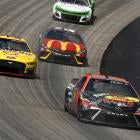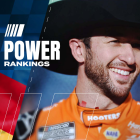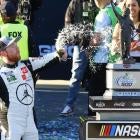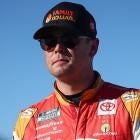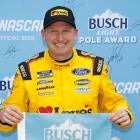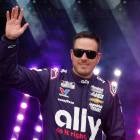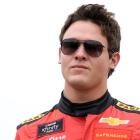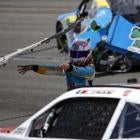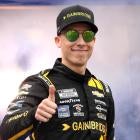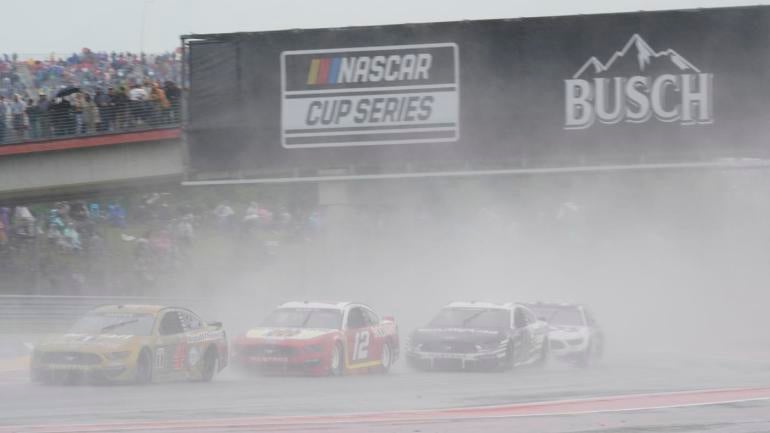
Whenever a NASCAR race is stopped due to rain, there is usually some chatter from those not familiar with stock car racing as to why America's highest level of auto racing generally does not race in wet conditions -- At least on ovals. Sunday, a road course race in the rain for the NASCAR Cup Series offered a very vivid and violent illustration of exactly what the hazards of racing in the rain are and the situations that it can create.
After rain hit the Circuit of the Americas in Austin, Texas, the EchoPark Texas Grand Prix ran mostly in wet weather conditions, with NASCAR bolting on the wet weather tires they bring to road courses and letting the field loose even past the point of acceptable risk.
As rain began to pick up throughout the day, visibility became a major issue as the spray from cars driving through the rain and over the wet racing surface severely compromised drivers' ability to see what was in front of them. And in an eight lap stretch from laps 20 to 28, things would begin to come to a head as conditions deteriorated to the point where drivers were blinded down one of the highest-speed sections of Circuit of the Americas.
On lap 20, Christopher Bell's race came to an end when he ran into the back of Ryan Blaney's car on the back straightaway, sending him skidding into the inside retaining wall. Alerted to what was going on in front of him, Kevin Harvick slowed down for the crash, but Bubba Wallace -- unable to see Harvick's car in front of his -- ran into the back of Harvick, ending both of their days.
The ensuing restart after the cleanup would see a similar situation yield a more frightening accident: After being unable to see Michael McDowell slow down in front of him, Martin Truex Jr. ran into the back of McDowell's car and was then hit at full speed by Cole Custer, who was unable to see the crash in front of him. Custer drove underneath of Truex's car, and then slammed the inside retaining barrier driver's side first. Both cars were destroyed, with Custer's momentarily catching fire.
A huge and frightening hit for Cole Custer and Martin Truex Jr. at Circuit of The Americas. pic.twitter.com/dGmCoXQPx6
— FOX: NASCAR (@NASCARONFOX) May 23, 2021
While no one was hurt, the drivers involved in the pair of accidents expressed enormous frustration with the situation and NASCAR's race operations. Speaking to Dustin Long of NBC Sports, Harvick issued scathing comments about how NASCAR didn't have "any business being out in the rain."
"All I can say is this is the worst decision that we've ever made in our sport that I've been a part of, and I've never felt more unsafe in my whole racing career. Period," Harvick said. "You can't see anything down the straightaways. These cars were not built to run in the rain, and when you can't see -- my spotter said 'Check up, check up' because he thought he saw two cars wrecking -- I let off and the guy behind me hit me wide open because he never saw me.
"It's unbelievable that we're out there doing what we're doing, because we're in race cars that aren't meant to do this. And if you can't see going down the straightaway, it's absolutely not safe. Not even close."
Truex was also outspoken, telling his team immediately after the crash that the situation was "[expletive] ridiculous" and that he "about died right there." Speaking to Fox Sports after leaving the infield care center, Custer said that he couldn't see a foot in front of his car. Speaking to his team over radio communications during the race, Denny Hamlin also had candid comments.
"I'm guessing since we can't see that's our problem and we're just going to race through this thing and try not to crash?", said Hamlin, via Jordan Bianchi of The Athletic. "I cannot wait for our safety meeting this week."
NASCAR tried to adjust for the situation, red flagging the race to clear standing water from the backstretch and also allowing teams to apply water repellents to their cars before the race was restarted. And after deteriorating conditions led them to red flag and eventually call the race official 14 laps shy of the finish, NASCAR effectively issued a mea culpa that it should have been more proactive and stopped the race earlier than they did.
"We always try to learn from what we do. This was kind of a new thing at a big, natural terrain road course. We will certainly learn from that," Scott Miller, NASCAR Senior Vice President of Competition, told reporters at the speedway. " ... I would kind of own the fact that maybe we did let it go a little bit too long there before we did something. But it's a learning experience for all of us. We will learn, we'll be better next time."
Sunday marked the second time in the past month that drivers expressed concerns about safety, as Joey Logano had been similarly outspoken about superspeedway racing after his car went airborne and flipped over in a crash at Talladega.
it is currently unclear as to exactly what changes NASCAR would make to their road racing operations in response to Sunday's incidents, and there is only a short turnaround before the Cup Series' next road course race at Sonoma Raceway on June 6.
The two crashes on the back straightaway marred a race which most of the field was able to finish, but even those who ended up leaving Austin intact felt that there were moments where the situation was harrowing. Even though second-place finisher Kyle Larson was quick to point out that there's "nothing safe about being a race car driver," he did acknowledge that certain moments were worse than others during the course of the day.
"There at the end, it was starting to rain pretty hard. You were having to deal with hydroplaning trying to go 170-something miles an hour," Larson said. "It was getting pretty crazy."
Sunday marked only the second time that the NASCAR Cup Series has raced in wet conditions. While the NASCAR Xfinity Series has run several wet weather races since 2008, the Cup Series' first foray into rain racing came last year at the Charlotte Motor Speedway Roval when a race was started in wet conditions before the track eventually dried out.














